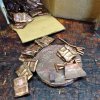- Joined
- Oct 4, 2017
- Messages
- 528
I recently got a bunch of copper wire and I plan to use it for handle spacers and liners.
My question is, can I build a square steel 'crucible' and melt and cool it in that? Then forge to shape later? I am thinking of removable sides to help get the bar out.
Thanks
My question is, can I build a square steel 'crucible' and melt and cool it in that? Then forge to shape later? I am thinking of removable sides to help get the bar out.
Thanks

